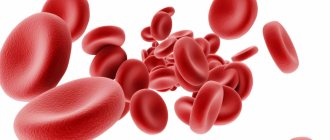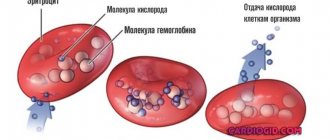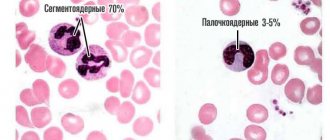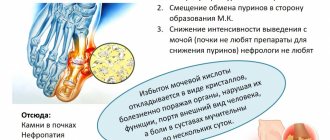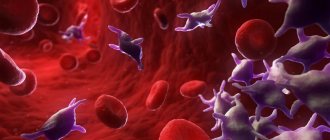Erythropenia
Red blood cell norms vary depending on gender and age:
- Adult men – 4.7±0.8*109 /ml;
- Adult women – 4.2±0.5*109 /ml;
- Newborns – 4.95±1.65*109 /ml;
- Children under 13 years old – 4.1±0.6*109 /ml.
Red blood cells carry hemoglobin, which provides oxygen to the tissues. When the number of red blood cells decreases, oxygen starvation occurs. Clinical manifestations are determined by the severity of erythropenia, the rate of decrease in the level of red blood cells and hemoglobin. In acute cases, symptoms quickly worsen over several hours. In a chronic process, the formation of a typical picture takes weeks or months, the body gradually adapts to changes in blood composition.
Anemia that develops with erythropenia is manifested by constant fatigue, weakness, weakness, loss of strength, decreased tolerance to physical activity, and decreased muscle mass. The patient is worried about tachycardia, headaches, dizziness, possible pre-syncope, fainting. Sexual desire decreases. The skin and mucous membranes become pale, hair becomes dull, and nails become brittle.
Against the background of secondary immunodeficiency, colds occur and fungal infections develop (stomatitis, thrush). Poor wound healing and frequent suppuration are noted. Caries progresses quickly. Defects in the mucous membrane form in the oral cavity and rectum. Seizures appear in the corners of the mouth. Possible nosebleeds and causeless bruising.
Anemia is the cause of low RBC
The most common cause of erythropenia is anemia of various origins:
- iron deficiency;
- B12 is deficient;
- hemolytic;
- hypoplastic.
The condition of anemia can be caused by hereditary factors or acquired during life. With B12 deficiency anemia, red blood cells decrease to 1* 10-12/l.
And if in the blood of an adult the red blood cells are reduced to the specified value or are less than 1* 10-12/l, then this indicates a severe form of anemia and means that it is necessary to immediately eliminate the cause that caused this condition in the patient.
Signs of increased erythropenia, increasing the risk of severe anemia, are the appearance of:
- Blood test after chemotherapy: normal, interpretation, general blood test
- shortness of breath, feeling of lack of air with little physical exertion;
- floaters before eyes;
- coldness, pallor of the skin, with massive destruction of red blood cells, yellowing of the skin is possible;
- yellowing of the eye sclera;
- dizziness;
- headache;
- weaknesses;
- low blood pressure;
- weak, rapid pulse;
- heartache.
Why does erythropenia occur?
Traumatic bleeding
They have a sharp character. The easiest to diagnose are external bleeding from cut and lacerated wounds with damage to an artery or vein. If the integrity of the artery is violated, the blood is bright red and flows out like a fountain. The skin is pale, tachycardia and hypotension rapidly increase, and loss of consciousness is possible. Damage to large arterial trunks without emergency medical care is fraught with death.
When a vein is injured, the blood is dark and flows out in a trickle. Erythropenia increases slowly, the condition, as a rule, remains satisfactory. In victims with puncture wounds, the severity of blood loss is not always obvious, since due to the narrow wound channel, the blood does not pour out, but into the tissues and cavities of the body. Bleeding is accompanied by all fractures, including closed ones. The degree of erythropenia correlates with the severity of blood loss, which depends on the location of the fracture and the presence of concomitant damage to nearby vessels.
Internal bleeding in the body cavity due to injuries such as:
- TBI.
Even in the absence of skull fractures, hematoma formation is possible. Erythropenia in such cases is insignificant due to the small amount of blood loss, but the accumulated blood compresses the brain tissue. - OGK injuries.
Damage to the pleura and lung from rib fragments during fractures with the development of hemothorax, as a rule, does not become a source of heavy bleeding. Severe erythropenia can be observed with stab and gunshot wounds of the lung with disruption of the integrity of large vessels. - Abdominal injuries.
Excessive internal bleeding is observed due to rupture of the liver or spleen due to blunt abdominal injuries. Severe erythropenia is also caused by gunshot, stab, and laceration wounds with damage to arteries and parenchymal organs. - Kidney damage.
It is a consequence of blunt trauma, wounds of the lumbar region. Erythropenia varies greatly in severity and is sometimes accompanied by significant blood loss.
Bleeding from the gastrointestinal tract
May be acute or chronic. The first place in prevalence is occupied by bleeding from the gastrointestinal tract, mainly from the stomach and esophagus. Along with erythropenia and signs of anemia, melena and vomiting of coffee grounds are manifested. Observed in the following pathologies:
- Mallory-Weiss syndrome;
- varicose veins of the esophagus in patients with cirrhosis of the liver;
- peptic ulcer, erosive gastritis;
- polyps, malignant tumors of the stomach and intestines;
- Crohn's disease, ulcerative colitis;
- embolism, thrombosis or rupture of aneurysms of the mesenteric arteries.
Erythropenia
Pulmonary hemorrhages
Chronic bleeding in diseases of acute hemorrhage is characterized by hemoptysis and blood in the sputum. Acute bleeding is preceded by a persistent dry and then wet cough, sometimes combined with a sensation of tickling, gurgling, or burning in the chest. The causes of erythropenia are:
- lung cancer and adenoma;
- pulmonary tuberculosis;
- pulmonary infarction;
- gangrene of the lung;
- bronchial foreign bodies;
- bronchiectasis.
Heart diseases in which blood loss from the lungs and bronchi with the development of erythropenia may occur include aortic aneurysm and mitral heart defects.
Uterine bleeding
A pathological condition accompanied by erythropenia occurs with tumors, uterine fibroids, inflammatory processes, and disorders of the blood coagulation system. A serious danger is postpartum hemorrhage, which develops as a result of uterine hypotension against the background of complicated pregnancy and childbirth, atrophy or hypertrophy of the endometrium after surgical interventions, and pathological processes in the uterus. Bleeding is especially difficult with uterine atony.
Hemolysis
Pathological hemolysis is accompanied by massive destruction of red blood cells, the development of erythropenia, and hemolytic anemia. Accompanies the following conditions:
- Poisoning
. The cause of toxic hemolysis is poisoning with arsenic, lead, nitrites, nitrates, chloroform, and aniline. Sometimes pathology occurs when taking medications such as sulfonamides, chloramphenicol, isoniazid. - Autoimmune anemias
. Erythropenia due to the destruction of red blood cells is observed in some connective tissue diseases (rheumatoid arthritis, SLE), malignant lesions of lymphoid tissue (chronic lymphocytic leukemia, Hodgkin lymphoma). - Mechanical damage to red blood cells
. It is observed in patients with microangiopathic hemolytic anemia. Sometimes accompanies arterial hypertension, renal artery stenosis, disseminated intravascular coagulation syndrome, and a condition after heart valve replacement.
Hereditary fermentopathies
Erythropenia is formed due to the absence or change in the structure of the enzyme that supplies red blood cells with glucose, which leads to disturbances in the properties and premature destruction of red blood cells. The most common enzymopathies are considered to be deficiency of pyruvate kinase and glucose-6-phosphate dehydrogenase. The phenomena of hemolytic anemia predominate.
Hereditary membranopathies
Hereditary defects in the red blood cell membrane cause changes in the shape and increased fragility of blood cells. Erythropenia is detected against the background of hemolytic anemia, accompanied by jaundice of the skin and an enlarged spleen. It is found in pathologies such as spherocytosis (Minkowski-Choffard disease), stomatocytosis, pyropycnocytosis. Another form of hereditary membranopathy is acanthocytosis, which develops with abetalipoproteinemia and some neurological diseases (McLeod syndrome, chorea-acanthocytosis).
Sickle cell anemia
With this hereditary hemoglobinopathy, hemoglobin has an atypical crystalline structure, and red blood cells have a sickle or crescent shape. Sickle cell anemia can be asymptomatic; when hypoxia occurs, it can manifest itself as fatigue, pallor, jaundice, and dizziness. In some cases, a severe course is possible with frequent hemolytic crises and the threat of sepsis.
Vitamin deficiencies
Erythropenia occurs due to insufficient intake of folic acid and vitamin B12 into the body. With a deficiency of these compounds, megaloblasts accumulate in the blood - large precursor cells of red blood cells with a short lifespan and a reduced ability to transport oxygen. As a result, patients develop pernicious anemia. Pathology is provoked by the following factors:
- Unbalanced diet
. A large amount of B12 is found in meat, fish, milk, eggs; a deficiency of the compound is more often observed in vegetarians, vegans, and people on strict diets. A lot of folic acid is found in plant foods, so patients who neglect vegetables and fruits suffer from its deficiency. - Intestinal diseases
. Due to malabsorption, vitamins enter the body in insufficient quantities during chronic colitis, enteritis, Crohn's disease, and neoplasms of the large intestine. - Castle factor deficiency
. Intrinsic factor Castle is produced in the stomach and transforms the inactive form of B12 into the active one. The deficiency is observed in atrophic gastritis, stomach cancer, the presence of an autoimmune conflict, and the condition after gastrectomy. - Infectious and parasitic diseases
. Some helminths (bovine and pork tapeworms in patients with taeniarinhosis, taeniasis) and microorganisms (actinomycetes in patients with abdominal actinomycosis) actively absorb vitamins from the intestines, which leads to absorption deficiency.
Oncological diseases
Erythropenia has the greatest clinical significance in acute leukemia with damage to bone marrow cells, which are the precursors of red blood cells - erythromyelosis. The disorder is also observed in other acute and chronic leukemias. Anemia is combined with intoxication, hemorrhagic, hyperplastic syndromes; the severity of manifestations is determined by the form and course of the disease.
Erythropenia is detected in the final stages of all cancers, regardless of the location of the pathological process. Considered as a type of paraneoplastic syndrome. Occurs as a result of appetite disturbances, exhaustion, and gastrointestinal bleeding. The latter causes a high probability of severe anemia due to stomach and colon cancer. In addition, radiation therapy can cause erythropenia.
Diagnostics
The specialty of the doctor who determines the causes of erythropenia is determined by the nature of the pathology. Patients with bleeding are examined by traumatologists, gastroenterologists, and pulmonologists. Patients with anemia require the help of a hematologist. To determine the severity of erythropenia and clarify the diagnosis, the following studies are prescribed:
- Clinical blood test
. Along with a decrease in the level of red blood cells, a drop in hemoglobin is often detected. Taking into account the characteristics of the disease, leukopenia, thrombocytopenia, reticulocytosis, and macrocytosis are possible. In erythromyelosis, erythroblastic cells are found. - Other laboratory tests
. Hemolytic anemia is accompanied by an increase in the level of bilirubin in a biochemical blood test. A decrease in the amount of B12 and folic acid indicates the development of vitamin deficiency. To confirm the oncological process, biopsies of bone marrow and various organs are taken, followed by morphological analysis. - Visualization techniques
. In patients with hemolytic anemia, an ultrasound scan of the abdominal cavity reveals an enlarged spleen. X-ray, CT scan of the chest, bronchoscopy are informative for pulmonary hemorrhages. Laparoscopy may be required to determine the source of abdominal bleeding. Fractures are diagnosed based on x-rays.
Diagnosis of erythropenia
What are the functions of cells?
These are blood cells that carry oxygen throughout the body. The process is as follows. Starting from the lungs, cells capture oxygen and continue to distribute it to all organs and tissues.
When the supply of capture ceases, the bodies return back for oxygen and at the same time capture carbon dioxide, simultaneously removing it from the body. That is why it is important to know the level of cells in the body, and also to monitor so that the number does not decrease.
Therefore, when getting an answer to the question of what red blood cells are responsible for in the blood, we can safely talk about high-quality oxygen pumping.
Treatment
Pre-hospital assistance
The wound should be covered with a pressure bandage; in case of arterial bleeding, a tourniquet should be applied to the thigh or shoulder. Fractures are fixed using a splint or improvised objects (planks, thick cardboard). A patient with non-traumatic bleeding is provided with complete rest. When bleeding through the mouth, the patient is placed in a position that prevents aspiration. The discharge of blood from the mouth or anus, the occurrence of melena, and vomiting of coffee grounds is a reason to immediately call an emergency medical team.
Conservative therapy
The tactics of conservative treatment are determined by the cause of erythropenia and the existing symptoms. Victims with fractures require immobilization using a plaster cast or skeletal traction. In case of gastric bleeding, an ice pack is placed on the stomach area; in case of pulmonary bleeding, tracheal aspiration is performed. Asphyxia is an indication for immediate intubation, blood removal, and mechanical ventilation.
To correct hypovolemia in erythropenia caused by significant blood loss, infusions of rheopolyglucin, dextran, native plasma or gelatin solution are performed. Posthemorrhagic anemia is eliminated by transfusion of red blood cells. The volume of medical care is determined by the severity of erythropenia, the general condition of the patient, and may include resuscitation measures, monitoring of diuresis and vital signs.
Patients with erythropenia due to vitamin deficiency are prescribed a special diet and vitamin preparations. The underlying pathology that caused the vitamin deficiency is treated. Iron deficiency anemia due to bleeding is considered an indication for the use of iron supplements. In case of hemolytic anemia, red blood cell transfusion is supplemented with glucocorticoids and iron-binding agents.
Treatment of erythropenia against the background of hemoblastosis involves the organization of aseptic conditions, mono- or polychemotherapy, blood transfusion therapy, irradiation of the spleen and lymph nodes. For malignant tumors of various locations, chemotherapy and radiation therapy are prescribed.
Surgery
Taking into account the causes of erythropenia, the following operations are performed:
- Traumatic bleeding
: PSO of wounds and open fractures, thoracotomy or laparotomy with elimination of the source of blood loss. - Gastrointestinal bleeding
: ligation or sclerosis of esophageal veins, endoscopic arrest of gastric or intestinal bleeding by puncture and electrocoagulation, suturing of ulcers, gastric resection, colon resection. - Pulmonary hemorrhage
: endovascular embolization of bronchial arteries, extrapleural filling, thoracoplasty, pulmonary artery ligation, pulmonary resection, pneumonectomy. - Oncological pathologies
: bone marrow transplantation for leukemia, surgical removal of tumors of various locations with part of the affected organ or the entire organ.
